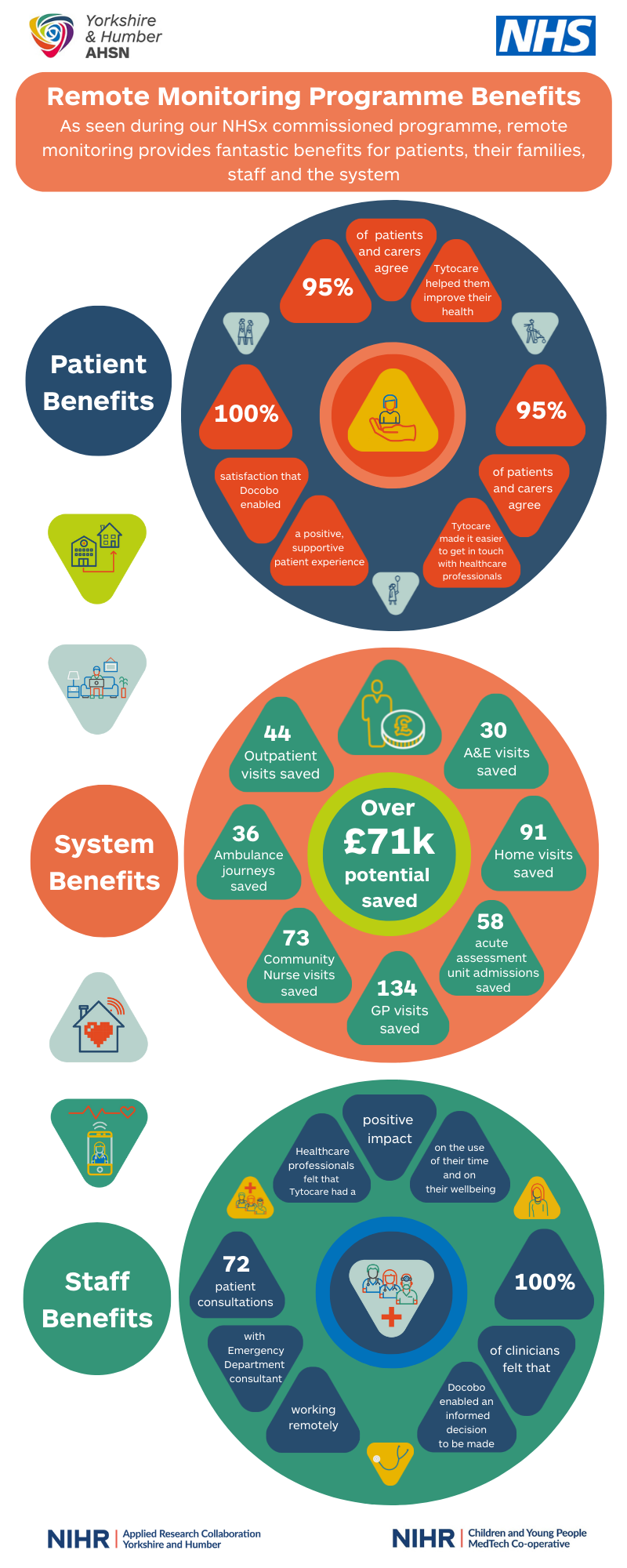How digital remote monitoring and virtual ward solutions help improve the delivery of patient care
Written by: Nicola Chicken - 21st September 2022

Keeping people well and providing care in the place they call home is a key priority for NHS England and it’s not surprising when you consider the vast benefits that are already being seen through projects across the country introducing Virtual Wards and Remote Monitoring. NHS England has set the ambition to deliver 40 to 50 virtual beds per 100,000 population by December 2023, with £450 million funding made available in total across 22/23 and 23/24 to support this aim. Planning is underway in earnest across Yorkshire and Humber Integrated Care Boards (ICBs) to enable these ambitious goals to be achieved in our region.
How have we helped so far?
In Yorkshire and Humber we have worked intensively over the last two years with colleagues across the three ICBs, NHS partners and innovators to bring new and enhanced Virtual Wards and Remote Monitoring technologies to the region, commissioned by NHSX (now integrated with the Transformation Directorate at NHS England). We took a tenacious approach to implementing three innovations; TytoCare, Docobo and HealthCall, into a wide variety of services, pathways, care settings and patient cohorts. Initiated as a rapid response to COVID-19, this quickly evolved into a spread and adoption piece piloting the three innovations across the system in primary care, acute trusts, hospitals, emergency departments and the care sector.
What are the benefits of Virtual Wards and Remote Monitoring?
Our programme demonstrated just how beneficial Virtual Wards and Remote Monitoring can be to patients, staff, the system and wider society. These benefits include reduced need for patients and their families to travel to traditional care settings such as GP surgeries, hospitals and Emergency Departments, which are particularly challenging for patients with mobility issues or patients who live far away from these settings. This of course also has the potential to prevent exposure of clinically vulnerable people to infectious diseases and illnesses. There is also the reassurance that patients and their families felt by having technology at home that supports them to access care where and when they needed it. This what a mum said about the benefits of having the TytoCare device in her home to care for her young daughter:
“I used the device several times in the middle of the night when my daughter’s symptoms were worse. It was reassuring that the Tyto told me how to take the readings and send them to a paediatrician. It has been brilliant. A huge weight off my shoulders.”
As part of the fantastic TytoCare evaluation work undertaken with our partners the Yorkshire and Humber Applied Research Collaboration, hosted by Bradford Institute for Health Research, and the National Institute for Health and Care Research Children and Young People MedTech Co-operative, and our own Docobo and HealthCall care homes evaluation, we also identified benefits to clinicians and other healthcare professionals including reduced need to travel to patients at home therefore enabling more efficient use of their time, enhanced clinical capability compared to standard telephone or video consultations and increased workforce flexibility.
In tandem with the patient, family and staff benefits are the benefits that Remote Monitoring provides to the system overall. Avoided face-to-face appointments in traditional healthcare settings such as GP surgeries, hospitals and emergency departments, provide a monetary benefit to the system. Wider societal benefits are also evident from these avoided face-to-face appointments, including the positive environmental impact of reduced carbon emissions through reduced travel.
The infographic shared here shows highlights of the wide-ranging patient, family, staff and system benefits seen during our programme over the last two years, as well as quotes from patients, their families and healthcare staff on their experience of Remote Monitoring during our programme.


What’s next?
The last two years have provided us with so many great opportunities for learning about Remote Monitoring and Virtual Wards, the benefits they can provide, the common challenges and risks, how to best approach implementation and how to ensure sustainability for the future. We are keen to share this learning with our colleagues in the ICBs to support them with their ambitions around Virtual Wards and Remote Monitoring.
Take a look at our series of resources providing lessons learnt and top tips in a range of formats including succinct practical guides, videos, podcasts and social media content, alongside interactive sessions such as workshops and action learning sets. We will take a phased approach to these resources to best cover the main stages of implementation: Start, Engage, Deliver, Embed, Sustain.
Keep your eyes peeled on our social media channels for these resources coming soon
Follow us on Twitter – LinkedIn – YouTube
If you have any questions or feedback please feel free to get in touch with Nicola Chicken, Project Manager at Yorkshire & Humber AHSN on: nicola.chicken@yhahsn.com
